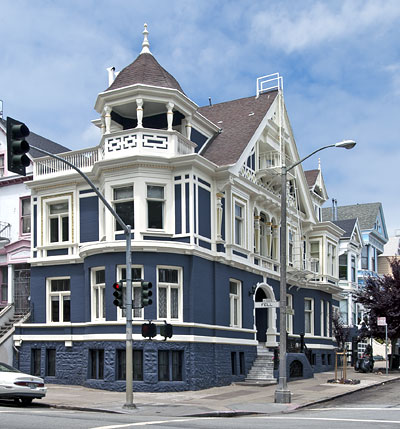San Francisco Landmarks
Thomas Jefferson Clunie House
301 Lyon Street At Fell
Built 1897
This house is a survivor. It outlived the era of Victorian elegance, survived an earthquake, a threat of demolition, the flower children and drug subculture, consciousness raising seminars, and [in 1981 when it was designated a San Francisco landmark] it was once again in residential use.
Architect William Curlett designed this Queen Anne house for Thomas Jefferson Clunie who was a lawyer, politician, and real estate speculator. When the house was built, the area still consisted of sand dunes. Clunie spared no expense, including the installation of a telephone.
Curlett used a variety of forms and materials to create an impressive structure for this corner site which today faces the Panhandle of Golden Gate Park adjacent to the Haight-Ashbury neighborhood. The three layer horizontal composition (concrete block base, brick first floor, and wooden upper floors) balances the vertical thrust of dormers, chimneys, gable roof, and corner bay capped by an open belvedere, one of only two remaining in San Francisco.
By the late 1960's the building had become home to the flower children and shortly thereafter to the drug subculture.
In 1973, a consciousness raising group, Theta Seminars, purchased the house to conduct seminars in rebirthing.
Adapted from San Francisco Planning Commission Resolution 8853, 19 February 1981.

Since 2002, the building has been owned by Westmont College, an evangelical Protestant college based in Santa Barbara, and used for student housing.

